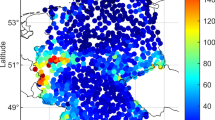Abstract
The SL-AV atmospheric model version using hybrid vertical coordinates combies the advantages of sigma and isobaric coordinates. The formulation and discretization of model equations maintain the equivalency of the new model version to the basic sigma version in the special case, when hybrid coordinates coincide with sigma coordinates. The SL-AV model version with hybrid vertical coordinate is verified with medium-range weather forecasts. The decrease in the errors of predicted geopotential height and wind as compared to the sigma model version is demonstrated. The use of hybrid coordinates also leads to a certain increase in forecast skill scores for some meteorological parameters characterizing aviation significant weather.
Similar content being viewed by others
References
E. M. Volodin and V. N. Lykosov, “Parameterization of Heat and Moisture Transfer in the Soil-Vegeiaiion System for Use in Atmospheric General Circulation Models: 1. Formulation and Simulations Based on Local Observational Data,” Izv. Akad. Nauk, Fiz. Atmos. Okeana, No. 4, 34 (1998) [Izv., Atmos. Oceanic Phys., No. 4, 34 (1998)].
A. R. Ivanova, “Method of Calcuiating Map of Maximum Wind,” Meteorol. Gidrol., No. 4 (1989) [Sov. Meteorol. Hydrol, No. 4 (1989)].
Meteorological Service for International Air Navigation. Annex 3 to the Convention on International Civil Aviation, 18th ed. (2013) [Transl. from English].
E. N. Skriptunova and N. P. Shakina, “An Automated Procedure for Forecasting Zones of Convective Activity,” Meteorol. Gidrol., No. 5 (1991) [Sov. Meteorol. Hydrol., No. 5 (1991)].
M. A. Tolstykh, Global Semi-Lagrangian Numerical Weather Prediction Model (OAO FOP, Moscow, Obninsk, 2010) [in Russian].
M. A. Tolstykh, J.-F. Geleyn, E. M. Volodin, et al., “Development of the Multiscale Version of the SL-AV Global Atmosphere Model,” Meteorol. Gidrol., No. 6 (2015) [Russ. Meteorol. Hydrol., No. 6, 40 (2015)].
N. P. Shakina and V. V. Borisova, “Experience of Using Potential Vorticity to Calculate the Height of the Tropopause,” Meteorol. Gidrol., No. 9 (1992) [Russ. Meteorol. Hydrol., No. 9 (1992)].
J. Dennis, J. Edwards, K. Evans, et al., “CAM-SE: A Scalable Spectral Element Dynamical Core for the Community Atmospheric Model,” Int. J. High Performance Computing Applications, 26 (2012).
J. R. Holton, Introduction to Dynamic Meteorology, 4th ed. (Elsevier, 2004).
M. Hortal, “The Development and Testing of a New Two-time-level Semi-Lagrangian Scheme (SETTLS) in the ECMWF Forecast Model,” Quart. J. Roy. Meteorol. Soc., 128 (2002).
A. McDonald and J. Haugen, “A Two-time-level, Three-dimensional, Semi-Lagrangian, Semi-implicit, Limited Area Grid-point Model of Primitive Equations. Part II: Extension to Hybrid Vertical Coordinates,” Mon. Wea. Rev., 121 (1993).
H. Ritchie, C. Temperton, A. Simmons, et al., “Implementation of the Semi-Lagrangian Method in a High Resolution Version of the ECMWF Forecast Model,” Mon. Wea. Rev., 123 (1995).
A. Robert, “A Semi-Lagrangian and Semi-implicit Numerical Integration Scheme for the Primitive Meteorological Equations,” J. Meteorol. Soc. Japan, Ser. II, No. 1, 60 (1982).
V. Shashkin, R. Fadeev, and M. Tolstykh, “3D Conservative Cascade Semi-Lagrangian Transport Scheme Using Reduced Latitude-longitude Grid (CCS-RG),” J. Comput. Phys., 305 (2016).
V. Shashkin and M. Tolstykh, “Inherently Mass-conservative Version of the Semi-Lagrangian Absolute Vorticity (SL-AV) Atmospheric Model Dynamical Core,” Geosci. Model. Dev., 7 (2014).
A. J. Simmons and D. M. Burridge, “An Energy and Angular Momentum Conserving Vertical Finite-difference Scheme and Hybrid Vertical Coordinate,” Mon. Wea. Rev., 109 (1981).
M. Tolstykh, “Vorticity-divergence Semi-Lagrangian Shallow Water Model on the Sphere Based on Compact Finite Differences,” J. Comput. Phys., 179 (2002).
M. Tolstykh and V. Shashkin, “Vorticity-divergence Mass-conserving Semi-Lagrangian Shaliow-water Model Using the Reduced Grid on the Sphere,” J. Comput. Phys., 231 (2012).
D. Wilks, Statistical Methods in the Atmospheric Sciences, 3rd ed. (Academic Press, 2011).
Author information
Authors and Affiliations
Corresponding author
Additional information
Original Russian Text © V.V. Shashkin, M.A. Tolstykh, A.R. Ivanova, E.N. Skriptunova, 2017, published in Meteorologiya i Gidrologiya, 2017, No. 9, pp. 24–35.
About this article
Cite this article
Shashkin, V.V., Tolstykh, M.A., Ivanova, A.R. et al. SL-AV atmospheric model version using σ-p hybrid vertical coordinates. Russ. Meteorol. Hydrol. 42, 554–563 (2017). https://doi.org/10.3103/S1068373917090023
Received:
Accepted:
Published:
Issue Date:
DOI: https://doi.org/10.3103/S1068373917090023



